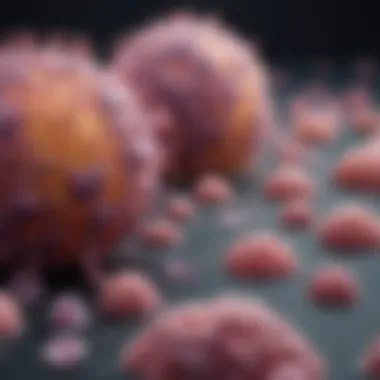Understanding Metastatic Breast Cancer: An In-Depth Guide


Intro
Metastatic breast cancer is a critical health challenge, affecting many individuals yearly. It occurs when cancer cells from the breast proliferate and spread to other organs, such as bones, liver, lungs, and brain. The complexity of this disease goes beyond its biological underpinnings, engaging various aspects of patient care and holistic treatment approaches.
A comprehensive understanding of metastatic breast cancer demands a multi-dimensional exploration, including its biological mechanisms, diagnostic processes, treatment modalities, and psychosocial impacts faced by patients and their families. The significance of timely diagnosis and evolving treatment options cannot be overstated, both for improving patient quality of life and enhancing survival rates.
This article will unfold the intricacies of metastatic breast cancer, examining recent research advancements, survival statistics, and the implications for ongoing patient care. It aims to equip readers with essential insights that contribute to informed discussions and decisions within the healthcare community.
Preamble to Metastatic Breast Cancer
Metastatic breast cancer presents a critical dimension within oncology. This condition signifies the phase where cancer cells migrate beyond the original site of the breast and establish new tumors in distant organs. Such a process not only complicates treatment but significantly impacts patient quality of life. Therefore, an accurate understanding of this stage of cancer is essential for healthcare professionals, researchers, and even caregivers.
Breast cancer is already one of the most prevalent cancers worldwide, with metastatic cases representing a significant subset. Understanding metastatic breast cancer helps clarify its behavior, treatment responses, and overall prognosis. As advancements in research progress, there is a growing need for ongoing education about the latest findings in this field. Key considerations include the variability of disease progression, diversified treatment approaches, and the necessity for a holistic patient care strategy.
The subsequent sections will delve deeper into defining metastatic breast cancer, its epidemiological landscape, and various clinical aspects to provide a robust foundation for understanding this disease.
Understanding Cancer Metastasis
Understanding cancer metastasis is crucial for grasping the nature of metastatic breast cancer. This process involves complex biological mechanisms that underlie how cancer cells spread from their original site in the breast to distant organs. Grasping these processes not only helps in diagnosis but also in designing effective treatment strategies.
The significance of studying cancer metastasis lies in its implications for improving patient outcomes. Development of effective therapeutic interventions relies heavily on a detailed comprehension of the metastatic process. By studying factors that facilitate metastasis, researchers can identify potential biomarkers that may serve as targets for innovative therapies. Moreover, understanding metastasis provides insights into patient prognosis and may lead to refinements in clinical practices.
Mechanisms of Metastasis
Metastasis involves several mechanisms that allow tumor cells to invade and disseminate throughout the body. The initial stage usually occurs when cancer cells detach from the primary tumor. Following this detachment, cells undergo a phenomenon known as epithelial-mesenchymal transition (EMT), allowing them to adopt a more migratory and invasive phenotype.
Once the cells are in circulation, they navigate through the bloodstream, often pausing at various sites. Upon entering new tissues, they must re-establish their growth properties, a process that may require several genetic adaptations. Key mechanisms include:
- Invasion: Cancer cells invade surrounding tissues after detaching from the tumor.
- Intravasation: This process involves cancer cells penetrating blood vessels to enter the circulatory system.
- Survival in Circulation: Metastatic cells must survive within the bloodstream, often by clustering with platelets or other blood components for protection.
- Extravasation: The ability to exit the circulation and migrate into new tissue is critical for forming secondary tumors.
Research continues to reveal that each of these mechanisms is regulated by a complex interplay of genetic and environmental factors. Increased understanding of these processes may lead to novel therapeutic approaches that can disrupt the metastatic cascade.
Pathways of Spread
Cancer cells can spread to different parts of the body through several pathways, which also vary in frequency and impact. Identifying these pathways is essential for developing targeted therapies and understanding metastasis's patterns. Major pathways include:
- Hematogenous Spread: This is the most common mode of metastasis in breast cancer. Tumor cells enter the bloodstream and can travel to organs such as the liver, lungs, and bones.
- Lymphatic Spread: Cancer cells may also spread through the lymphatic system. This pathway often leads to regional lymph nodes and can be a primary indicator of metastatic spread.
- Transcoelomic Spread: Some cancers can spread across surfaces of body cavities, often seen in abdominal cancers.
Understanding the different pathways is essential for decision-making in treatment and interventions. For instance, metastatic breast cancer may necessitate systemic therapies targeting specific organ sites based on where cells have spread. Insights on the patterns and mechanisms of cancer metastasis provide a roadmap for both ongoing research and clinical application.
Biological Characteristics of Metastatic Breast Cancer
The biological characteristics of metastatic breast cancer play a crucial role in understanding the disease as a whole. This section focuses on significant elements such as the tumor microenvironment and the role of cellular markers and genetic factors. It is essential to grasp these details to comprehend how metastatic breast cancer progresses and how it can be effectively treated.
Tumor Microenvironment
The tumor microenvironment refers to the surrounding cellular environment that influences tumor behavior. It consists of various components, including immune cells, blood vessels, and extracellular matrix. This complex setting is not passive; rather, it actively participates in tumor growth and metastasis.
- Cellular Interactions: The interactions between cancer cells and the surrounding cells can promote aggressive behaviors. For instance, cancer cells may manipulate normal cells to support their growth.
- Immune Evasion: The microenvironment can suppress the immune system, allowing cancer cells to escape detection and destruction. This evasion is pivotal for the establishment of secondary tumors.
- Angiogenesis: Cancer cells induce the formation of new blood vessels. This process, known as angiogenesis, is vital for delivering nutrients and oxygen to growing tumors.
Understanding these elements helps researchers identify potential therapeutic targets. Improving the microenvironment could enhance treatment effectiveness and patient outcomes.


"The tumor microenvironment is a dynamic landscape that interacts closely with cancer cells, influencing their behavior and therapeutic response."
Cellular Markers and Genetic Factors
Cellular markers and genetic factors provide further insights into the biological characteristics of metastatic breast cancer. These markers are crucial for diagnosis, prognosis, and treatment decisions.
- Biomarkers: Specific proteins or genetic mutations can indicate the likelihood of metastasis. For instance, overexpression of HER2 is associated with aggressive forms of breast cancer.
- Genetic Mutations: Mutations in genes such as BRCA1 and BRCA2 can significantly increase the risk of developing breast cancer and its metastatic potential. Understanding these mutations can guide treatment and preventive strategies.
- Tumor Heterogeneity: Metastatic breast cancer is not uniform. Different tumor cells may have distinct genetic and cellular features. This heterogeneity poses a challenge in treatment, as some cells may become resistant to therapies designed to target a single tumor type.
In summary, understanding the biological characteristics of metastatic breast cancer is vital. Insights into the tumor microenvironment and the role of specific markers and genes can inform treatment strategies and improve patient care. A comprehensive exploration of these aspects offers hope for advancements in both research and therapeutic approaches.
Diagnosis of Metastatic Breast Cancer
Diagnosing metastatic breast cancer is a critical component of managing the disease effectively. This stage can significantly influence treatment choices and patient outcomes. Early and accurate diagnosis can facilitate timely interventions, ultimately improving quality of life. Given the complexity of the disease's progression, understanding the nuances of the diagnostic process becomes essential for both healthcare professionals and patients.
Clinical Presentation and Symptoms
The clinical presentation of metastatic breast cancer varies widely among patients. Early symptoms may include persistent pain in bones or joints, swelling in the lymph nodes, and changes in previously healthy tissue. Patients often report unexplained weight loss, fatigue, and difficulty breathing. As the disease advances, the presence of distant metastases often leads to more severe manifestations, depending on which organs are involved.
Several key factors can influence how symptoms present:
- Location of Metastases: If cancer spreads to bones, it may cause localized pain. If it spreads to the lungs, patients might experience persistent cough or chest pain.
- Size of Tumor: Larger tumors typically exert more pressure on surrounding organs, intensifying discomfort or pain.
- Individual Variation: Each patient’s response to metastatic disease varies, creating a spectrum of symptoms.
Recognizing these symptoms and their implications for health is vital for early intervention and management.
Diagnostic Imaging Techniques
Diagnostic imaging plays a crucial role in identifying and monitoring metastatic breast cancer. Various techniques are employed to visualize the extent of cancer spread:
- Mammography: Typically the first line of imaging, it aids in confirming the diagnosis in breast tissue.
- CT Scans: These provide detailed images of internal organs and are particularly useful in identifying metastases within the chest, abdomen, and pelvis.
- MRI Scans: Particularly effective in visualizing the brain and spinal column, MRI scans help detect metastasis in these critical areas.
- Bone Scans: This technique is essential for detecting early changes in bone metabolism associated with cancer spread to bones.
Each imaging modality has its unique advantages. Selecting the appropriate technique depends on clinical judgment. Analyzing the results from these imaging techniques is vital for forming an accurate clinical picture, thus enhancing treatment planning.
Biopsy and Pathology
A definitive diagnosis of metastatic breast cancer often necessitates a biopsy. The biopsy is the process of obtaining tissue samples to examine under a microscope. Pathologists analyze these samples to confirm whether cancer cells are present and identify specific characteristics associated with the cancer.
Several types of biopsy methods include:
- Fine Needle Aspiration (FNA): A minimally invasive procedure, usually used for accessible tumors.
- Core Needle Biopsy: This method removes a larger tissue sample, providing more information for pathology.
- Surgical Biopsy: Used when other methods are inconclusive or when a more comprehensive examination is necessary.
Pathology reports from biopsies provide critical information about the cancer type and its characteristics, influencing treatment choices. Understanding the intricacies of the diagnostic process facilitates better therapeutic decisions and can lead to improved patient outcomes.
Accurate and timely diagnosis of metastatic breast cancer is essential to enhance treatment effectiveness and improve patient quality of life.
Treatment Strategies for Metastatic Breast Cancer
The treatment strategies for metastatic breast cancer are critical in the management of this complex disease. The main goal of treatment is to control the cancer progression, relieve symptoms, and improve the quality of life for patients. Each treatment plan must be individualized, considering the specific characteristics of the cancer, the patient’s overall health, and their preferences. The intersection of various therapeutic approaches provides an arsenal against this challenging disease.
Systemic Therapies
Systemic therapies play a pivotal role in the treatment of metastatic breast cancer. This category includes chemotherapy, hormonal therapy, and targeted therapy, all designed to act throughout the whole body.
- Chemotherapy involves the use of cytotoxic drugs that kill rapidly dividing cells. It is often utilized for aggressive forms of breast cancer and can be combined with other treatments.
- Hormonal therapy is effective in cancers that are hormone receptor-positive. Drugs such as anastrozole or letrozole help block the body's natural hormones that promote tumor growth.
- Targeted therapies, such as trastuzumab, specifically target cancer cells with certain biological markers. This precision medicine approach can enhance the effectiveness of treatment while mitigating side effects.


Targeted Therapies
Targeted therapies represent a significant advancement in the treatment of metastatic breast cancer. These therapies focus on the specific genetics of a patient’s cancer cells. For example, HER2-positive breast cancers can be treated effectively with agents like trastuzumab and pertuzumab.
Using targeted therapies can offer several advantages:
- Enhanced effectiveness against specific cancer types.
- Reduced side effects, as these therapies often spare healthy cells.
However, there are considerations in using targeted therapies. It is crucial to conduct genetic testing to ensure that patients have the appropriate markers for these drugs.
Radiation Therapy
Radiation therapy is another important modality in managing metastatic breast cancer, especially for localized pain or specific metastasis sites like bones or brain. Radiation can shrink tumors, alleviate symptoms, and enhance the quality of life.
- Mechanism: It works by damaging the DNA of cancer cells, leading to cell death.
- Application: It can be delivered externally or internally depending on needs.
While effective, it is essential to weigh the potential side effects against the benefits.
Emerging Therapies
The landscape of treatment for metastatic breast cancer continues to evolve with innovative therapies entering the clinical arena.
- Immunotherapy, which leverages the patient's immune system to fight cancer, is showing promise, particularly in specific subtypes of breast cancer.
- Combination therapies are being explored to maximize effectivity, such as pairing immunotherapies with traditional treatments.
- Clinical trials are vital for discovering new therapies. Participation can provide patients access to cutting-edge treatments that are not widely available.
The future of metastatic breast cancer treatment lies in personalization, utilizing research and technological advancements to tailor approaches for each patient. This leads to better outcomes and improved survival rates.
Managing Side Effects of Treatment
In the treatment of metastatic breast cancer, managing side effects is a crucial component of patient care. Patients often endure various responses to therapies, which can impact their quality of life. Understanding these side effects is essential for developing strategies to mitigate them.
Some common side effects arise from systemic therapies like chemotherapy and targeted treatments. These effects, including fatigue, nausea, and hair loss, can vary from mild to severe. Addressing these side effects not only improves the patient's comfort but also encourages adherence to treatment plans. Understanding the range of side effects empowers patients and caregivers to anticipate challenges and seek timely interventions.
Identifying and managing side effects can significantly impact overall treatment success. Effective management can lead to enhanced recovery and improved outcomes. Therefore, supportive care becomes a vital consideration in the therapy process.
Common Side Effects from Therapy
Metastatic breast cancer treatments can lead to numerous side effects. Some of the more prevalent issues include:
- Fatigue: Many patients report extreme tiredness that does not improve with rest. This exhaustion can hinder daily activities and reduce motivation.
- Nausea and Vomiting: These effects can be disruptive, especially during chemotherapy. Patients may dread treatment days due to fear of these symptoms.
- Skin Changes: Treatments may cause rashes, dryness, or sensitivity, affecting one's self-image and comfort.
- Bone Marrow Suppression: This serious side effect can lead to anemia, increasing fatigue and the risk of infection.
- Neuropathy: Some therapies can cause nerve damage, leading to numbness or tingling in the extremities.
Recognizing these side effects is the first step in addressing them. Patients should communicate openly with their healthcare providers about any issues they experience. This dialogue is crucial for timely supportive interventions to enhance comfort and safety during treatment.
Supportive Care and Palliative Measures
Supportive care involves a range of therapeutic techniques aimed at improving quality of life for metastatic breast cancer patients. It can include:
- Nutritional Support: Maintaining proper nutrition can combat weight loss and improve energy levels. Nutritionists can provide individualized meal plans.
- Pain Management: Palliative care options focus on pain relief, allowing patients to engage more fully with their treatment journey.
- Counseling Services: Access to mental health professionals can help address emotional burdens associated with cancer and treatment.
- Physical Therapy: Personalized exercise programs can alleviate fatigue, maintain mobility, and enhance overall well-being.
"The goal of supportive care is not just to extend life but to enhance the quality of life for those affected by metastatic breast cancer."
Both supportive care and palliative measures focus on the patient's holistic needs. These interventions are essential for navigating the challenging landscape of metastatic breast cancer therapy. By integrating these strategies into usual cancer treatment plans, healthcare providers can significantly improve patients' experiences, both physically and emotionally.
Psychosocial Impact of Metastatic Breast Cancer


The psychosocial impact of metastatic breast cancer is a vital aspect not only for patients but also for their families and healthcare providers. This facet is often overlooked in clinical discussions but has profound effects on overall wellbeing and treatment efficacy. Patients facing metastatic breast cancer endure significant emotional burdens resulting from their diagnosis. The reality of living with a chronic condition significantly alters their day-to-day experiences and relationships.
Emotional and Mental Health Challenges
Metastatic breast cancer can lead to a range of emotional and mental health challenges. Many patients experience anxiety, depression, and feelings of isolation. These feelings may arise from the persistent nature of their disease, uncertainty about the future, and the impact on their identity. The psychological struggle often manifests in various ways, including fear of disease progression and concerns regarding the impact on family dynamics.
For many patients, the uncertainty of their prognosis creates a mental landscape filled with fear and dread. It is essential to recognize these challenges as they can affect not only the patient's mental health but ultimately their physical health as well.
Coping mechanisms differ among individuals. Some may seek therapy or join support groups to channel their feelings. Psychosocial interventions can play a crucial role in treatment, helping to mitigate stress and enhance emotional resilience. Integrating discussions about mental health into routine care can improve patient outcomes considerably.
Support Systems and Resources
Building a robust support system is essential for patients navigating the complexities of metastatic breast cancer. Friends, family, and healthcare professionals serve critical roles in providing emotional support, nutrition, and practical assistance. Additionally, accessing community resources can significantly bolster the psychosocial experience.
Support groups, both in-person and online, offer patients platforms to share their experiences and connect with others facing similar situations. Websites like reddit.com host communities where individuals can find comfort and shared insights.
Key resources include:
- Mental health professionals: Psychologists and counselors who specialize in oncology can provide personalized support.
- Patient advocacy groups: Organizations advocating for metastatic breast cancer can offer resources and connect patients with others.
- Peer support networks: Some patients benefit from mentorship from those who have navigated similar journeys.
- Educational workshops: These can equip patients and caregivers with tools to manage the psychosocial aspects of cancer.
In summary, the psychosocial impact of metastatic breast cancer warrants careful consideration. Emotional challenges and the necessity of robust support systems are critical in enhancing the quality of life for patients. By addressing these aspects, healthcare providers and families can play pivotal roles in supporting patients throughout their journey.
Research and Future Directions
Research in metastatic breast cancer is critical, given the complex and multifaceted nature of this disease. Understanding the biological mechanisms of metastasis can lead to better targeted therapies and improve overall patient care. Researchers are focusing on identifying genetic and molecular markers that characterize different metastatic behavior, which may aid in developing personalized treatment plans. Moreover, continuous investigation into how cancer cells interact with the tumor microenvironment is necessary. These insights can help in creating effective therapies that inhibit cancer spread and improve patient survival rates.
Current Research Trends
Recent studies indicate a shift toward understanding the interplay between immune response and metastatic breast cancer. Immunotherapy is gaining traction as a viable treatment option. Current research is also exploring:
- Biomarkers for early detection: Identifying specific molecules in the blood that signal the presence of metastasis can improve diagnostic timelines.
- Genetic profiling of tumors: Tailored therapies based on genetic characteristics of individual tumors can enhance treatment effectiveness.
- Role of micro-RNAs: Investigating how small non-coding RNAs influence metastasis may reveal new therapeutic targets.
These trends reflect a transformative phase in research, emphasizing the integration of technology and biology to combat metastatic breast cancer.
Innovative Approaches in Treatment
Innovative approaches in treatment are essential to improve outcomes for patients with metastatic breast cancer. Current strategies under exploration include:
- Combination therapies: Utilizing a blend of traditional chemotherapy, targeted therapies, and immunotherapy can enhance the efficacy of treatment.
- Gene editing technologies: Techniques such as CRISPR are being tested to target specific genes involved in cancer spread and proliferation.
- Nanotechnology: The use of nanoparticles for drug delivery can improve precision in targeting cancer cells while minimizing damage to healthy tissues.
- Cancer vaccines: Active research is underway to develop vaccines that can train the immune system to identify and attack metastatic cells more effectively.
"Staying at the cutting edge of research is vital for devising effective treatments for metastatic breast cancer."
It is important for students, researchers, and healthcare professionals to stay informed about these trends and advancements. The future of metastatic breast cancer treatment is promising, driven by continuous research and innovative methodologies.
Finale
In summarizing the complex landscape of metastatic breast cancer, several key elements emerge that underpin the discourse presented in this article. Firstly, understanding the intrinsic nature of this disease is crucial. Metastatic breast cancer is characterized by the spread of malignant cells beyond the original site, necessitating a multifaceted approach to treatment and care. The implication of such complexity extends not just to biomedical research but permeates the entire spectrum of patient management, highlighting the urgency of tailored therapeutic strategies.
Summary of Key Findings
- Biological Nuances: The article elucidates how metastatic breast cancer arises from intricate genetic and molecular interactions within the tumor microenvironment. These factors significantly dictate the disease's progression and response to treatment.
- Diagnosis and Imaging: An emphasis on advanced imaging and biopsy techniques demonstrates their essential roles in timely and accurate diagnosis. These methodologies not only aid in determining the extent of spread but also influence treatment decisions.
- Therapeutic Approaches: The article details various systemic therapies, including chemotherapy and targeted therapies, that target specific pathways in metastatic breast cancer cells. Importantly, the effectiveness of these treatments often hinges on an understanding of individual genetic profiles, advocating for personalized medicine.
- Psychosocial Dimensions: Finally, beyond the physical ramifications of the disease, the article sheds light on the emotional and mental health challenges faced by patients. Establishing robust support systems is pivotal in addressing these challenges, enhancing overall quality of life.
The Importance of Awareness and Research
Ongoing awareness and research are indispensable in the fight against metastatic breast cancer. Increased understanding can lead to earlier detection, better treatment pathways, and potential breakthroughs in therapeutic options. Additionally, fostering a culture of awareness can promote research funding and collaboration among stakeholders in the field.
- Educational Initiatives: Raising awareness through educational campaigns can provide critical information regarding risk factors, symptoms, and available treatments. Patients and their families benefit from being informed about the resources at their disposal.
- Research Investment: Continuous investment in research is vital. Funding for innovative approaches such as immunotherapy and genetic profiling can pave the way toward more effective treatments and new clinical trials.
"Advancements in metastatic breast cancer research are not just academic endeavors; they represent the lifeline for many who are directly impacted by this condition."















